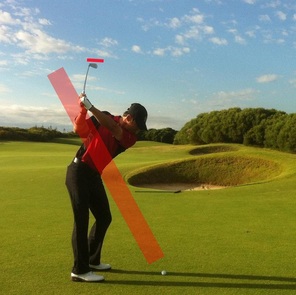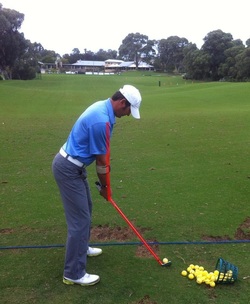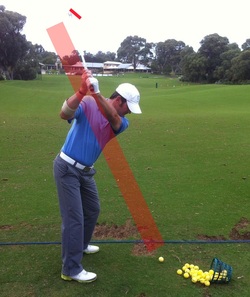Golf On Tour: How a Scratch Handicap Golfer Improved His Golf Swing Faster Than You Can Boil Water12/5/2012
 Recently we worked with David a scratch handicap golfer who spent four weeks with us at Pro Tour Golf College, our high performance golf college in Perth, Western Australia. His goal was to lower his competitive score average so that he can play well enough to qualify to play golf on a professional golf tour. Amongst other things David wanted to improve a technical flaw in his backswing that was leading to inconsistent ball striking and directional issues as well as improve his bunker play and lob shots. In this blog I’ll discuss the approach we took to modifying and ultimately improving this technical flaw in his backswing, a change that has helped him to greatly improve his control over the distance and direction when he hits his full shots with irons and woods. At Pro Tour Golf College we share with our students that the goal for us isn’t to change their swing to some ‘ideal’ swing model but rather to adjust it so that it can consistently produce three simple and essential outcomes. 1. To hit the ball where the clubface is pointing consistently 2. To hit the ball more out of the sweet spot consistently 3. To hit the ball with minimal curvature consistently These might seem like obvious factors you would want to control in your swing but it is surprising to us how many advanced level golfers that attend our program are more focused on the look or style of their swing rather than its ability to produce these three outcomes consistently.  So here’s where we started. David has a very strong tendency for the golf club to travel too much behind him too quickly leading to a swing plane that was too flat for him to produce straight and consistent shots. Coupled with this and because of the flat plane angle the clubface was also more on the closed side of where it ideally should be. This combination for David under pressure leads to shots that travel too much to the right of the target and hooks that travel too quickly to the left. This made it difficult for him to gain the level of control he needed to become a competitive golfer on a professional golf tour. This stroke pattern might be fine for a higher handicapped amateur golfer who wants to hit shots that start to the right of the target and hook back to left. Many successful amateur golfers learn to hit this type of golf shot in getting their handicaps down into single figures.  David had two strong tendencies in his technique that lead to a consistently flat backswing angle. The first was a high hand position at address where the shaft bisected the body above his belt line, and the second is the hands were more in a straight line with the club-shaft similar to an impact position. The one other factor was he tended to favour his right leg and hip at address which actually allowed him to use it as a pivot point in the backswing which further encouraged the flat back-swing arc. The high and forward hands address angle coupled with the weight displacement favouring the right hip promoted a very quick movement of the club-head to the inside on the backswing and this strong tendency meant that he struggled to develop a transition that set his golf swing up for sound and consistent impact.  So we explained to David that we would alter his back-swing shape by establishing a different set of set-up conditions which I describe from the front and side angles that made it a lot easier for him to develop a slightly steeper back-swing plane angle. Firstly from the front side we centered his hands so that he formed an angle between his left forearm and the shaft rather than having them in a line and focused more pressure into the inside of his left leg without moving his upper torso in-front of the ball. The other minor adjustment was to flare his right foot outwards approximately 20 degrees to help his hip to rotate correctly around his right knee and thigh. We’re firm believers that it is easier to initiate change by setting up conditions that force the golf club to behave differently to its normal pattern. Of course this would never be enough on its own, because David’s strong tendency for the golf club to travel quickly to the inside is automatic so we needed to also add a different wrist activation pattern in the early stages of the back-swing.  From the target side view you can see how we altered his shaft address angle so that his right arm was allowed to hang almost straight down from his shoulder. You can also see that there is a greater angle formed between his right arm and the club-shaft angle. We explained to David that these presets are established in his new address routine to make it easier to help him to change his back-swing shape more easily and effectively. We suggested to David that as his hands were passing his right knee that he cock the shaft angle in such a way that the golf shaft and club-head travelled more in-front of him. We’re firm believers that it is easier to initiate change by setting up conditions that force the golf club to behave differently to its normal pattern. Of course this would never be enough on its own, because David’s strong tendency for the golf club to travel quickly to the inside is automatic so we needed to also add a different wrist activation pattern in the early stages of the back-swing.  In the photo to the left notice the angle of the nearly transparent white line and how it travels in-front of the right elbow and through the right shoulder? That is the trajectory we worked on achieving with the golf club. The key to achieving this was to make sure that David did not change the original preset shaft to forearm angle (red lines) until the golf club started upwards on the correct path. It’s important to point out that David practiced this change in his back-swing everyday for a minimum of two hours for five days per week over four weeks.  The hours practiced combined with the discipline to make sure that the club was moving deliberately and correctly was important for David to return home knowing that he was on the way to incorporating the change into his existing technique. Like any new pattern of movement it is only as strong as the amount of regular practice that is done to reinforce it. Remember the expression in learning theory of “use it or lose it?” Well, learning a new motor pattern is exactly the same. If you cease to practice the new pattern continually, the old pattern will return with a vengeance. A change such as the one described for an average amateur golfer would require a minimum of ten hours with a competent golf instructor and fifty hours of deliberate practice to get it to the stage of being able to trust it implicitly in a competitive environment. It is easy to believe that you can change some aspect of your golf swing technique with a little information from a golf magazine or DVD and some practice. This is far from the reality of actually being able to create lasting change. David is hitting the ball more solid and straight as a result of the changes we have introduced and is consistently achieving the three ball-flight factors of straight, solid, and with minimal curvature but he knows that to get it to the stage of unconscious competence in tournaments he will have to continue working on the presets and swing change for at-least another six months to be able to completely rely on it when it really matters. David and Lawrie Comments are closed.
|
Archives
June 2019
|
Proudly Supported By
Copyright © 2011 - 2018 Pro Tour Golf College
Website Managed By Golf Performance Media
All Rights Reserved
Website Managed By Golf Performance Media
All Rights Reserved


 RSS Feed
RSS Feed



